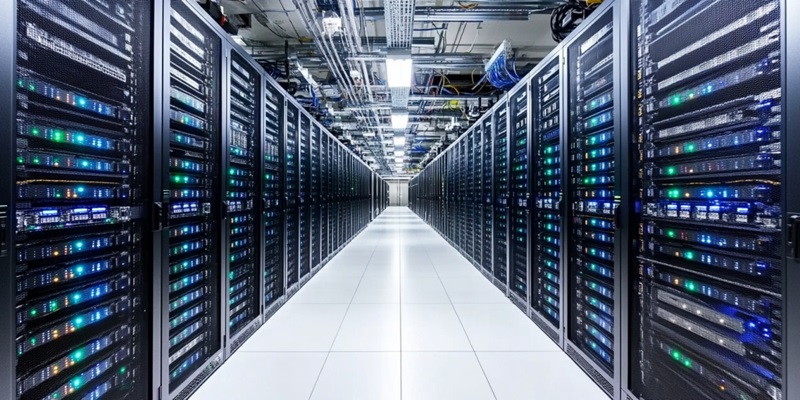As the relentless advancement of artificial intelligence drives data center cooling systems to their limits, densely packed servers generate extreme heat requiring industrial-scale cooling solutions. Traditional cooling methods struggle to manage the increasing loads, creating a critical challenge for the industry. Forecasts by Goldman Sachs suggest a 160% rise in data center power requirements by 2030, emphasizing the urgent need for more efficient and sustainable cooling technologies.
Innovations from the University of Texas
Engineering a Breakthrough
The University of Texas at Austin has introduced an innovative solution in the form of a thermal interface material that promises to revolutionize how data centers manage heat. The cutting-edge material, created by combining liquid metal Galinstan with ceramic aluminum nitride through a sophisticated mechanochemical process, offers a remarkable 72% improvement in cooling efficiency over existing technologies. This novel approach also translates to a 5% reduction in overall energy consumption, highlighting significant strides in operational efficiency and sustainability for data centers.
This breakthrough material’s capability extends to dissipating 2,760 watts of heat from a 16-square-centimeter area, a feat that could decrease cooling pump energy requirements by a staggering 65%. Considering AI applications alone could add 200 terawatt-hours annually to data center power consumption by 2030, and with cooling already consuming roughly 40% of energy use, such advancements are not just welcome but essential. Professor Guihua Yu highlights the potential of this innovation to address the escalating power demands of data centers effectively.
Addressing Critical Challenges
This new material not only bridges the gap between theoretical and practical cooling potential but also sets a sustainable precedent for high-power electronics. By enhancing cooling efficiency, it is paving the way for more compact and energy-efficient data centers, which is crucial as the digital infrastructure grows to support AI advancements. Lead author Kai Wu elaborates on the broader implications by suggesting that this innovation could foster eco-friendly technologies across various fields, from data centers to aerospace.
The initial tests of this material have so far been conducted on smaller lab-scale devices. However, the research team at the University of Texas is focused on scaling up material synthesis, with plans to collaborate with data center partners to test the technology’s efficacy in real-world settings. By ensuring that the material performs effectively under larger, more demanding conditions, the team aims to validate its capacity on a practical scale, pushing the boundaries of current cooling technologies.
Implications for the Future
Expanding Data Center Capabilities
The introduction of superior thermal interface materials signifies a new era of thermal management efficiency. As data center capabilities continue to expand, this innovation promises to drive cost savings while supporting the sustainable growth of digital infrastructure critical for AI advancements. The environmental impact of more efficient cooling systems extends beyond just reducing energy consumption; it also minimizes the carbon footprint of data centers, aligning with global sustainability goals.
By mitigating the high energy demands of cooling systems, the new technology aids in maintaining a balance between performance and sustainability. For data centers that house extensive AI operations, achieving higher operational efficiency without sacrificing processing power or generating excess heat is a critical milestone. This technological leap not only ensures reliability but also improves the overall efficiency of data operations, presenting an all-encompassing solution to a previously daunting challenge.
Envisioning Sustainable Growth
The promising results from the University of Texas’s research reinforce the potential for more sustainable solutions in high-performance computing environments. As AI workloads continue to grow exponentially, technologies like this thermal interface material become invaluable in maintaining manageable energy consumption levels. Beyond immediate energy savings, these advancements contribute to the long-term strategic planning and sustainability initiatives of tech companies globally.
Looking ahead, the scaling and practical applications of this technology could redefine data center management. Engaging in collaborations with industry stakeholders and pushing forward with real-world tests represents the next logical step in ensuring the widespread adoption and optimal performance of this cooling solution. Ultimately, this innovation holds the potential to provide robust support for the rapid, sustainable expansion of AI, leading to smarter, more efficient data centers.
Conclusion
As the relentless march of artificial intelligence pushes data center cooling capabilities to their maximum, the overcrowded servers generate tremendous heat that demands substantial, industrial-scale cooling solutions. Traditional methods of cooling often fall short when handling these rising loads, presenting a significant challenge for the sector. Projections by Goldman Sachs indicate a staggering 160% increase in data center power needs by the year 2030, underscoring the pressing requirement for more efficient and sustainable cooling technologies. This dramatic upswing in energy demands signifies not only the growing computational capabilities but also highlights the essential role and need for innovation in cooling systems to manage this technological boom. As data centers continue to expand in both size and complexity, the integration of advanced cooling technologies becomes paramount to ensure energy efficiency and environmental sustainability, while maintaining the robust performance demanded by AI advancements. The industry must rapidly adapt to these evolving needs to prevent bottlenecks and ensure continued progress.

